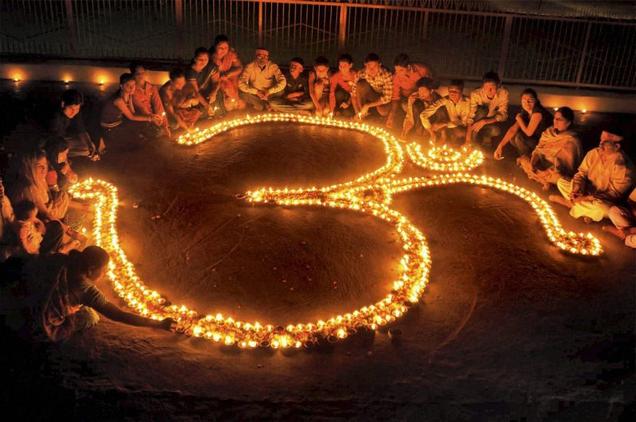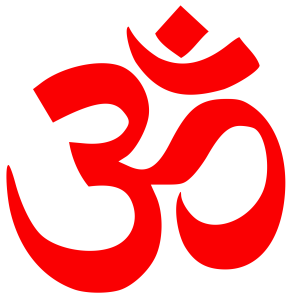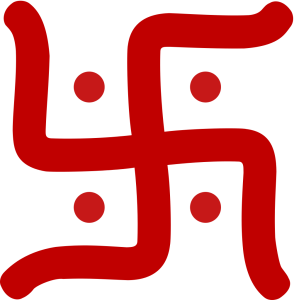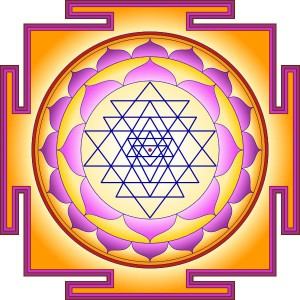No products in the cart.
Universal symbols in context to Hinduism are those common symbols that are used as a mark to faith in God, power and peace. There are majorly three universal symbols in Hinduism
- Om
- Swastika
- Sri Yantra
OM
In Hinduism, Om (also spelled Aum) is a Hindu sacred sound that is considered the greatest of all mantras. The syllable Om is composed of the three sounds a-u-m (in Sanskrit, the vowels ‘a ‘and ‘u’ combine to become o) and the symbol’s threefold nature is central to its meaning. It represent several important triads:
- The three worlds – earth, atmosphere, and heaven
- The three major Hindu gods – Brahma, Vishnu, and Siva
- The three sacred Vedic scriptures – Rig, Yajur, and Sama
Thus Om mystically embodies the essence of the entire universe. This meaning is further deepened by the Indian philosophical belief that God first created sound and the universe arose from it. As the most sacred sound, Om is the root of the universe and everything that exists and it continues to hold everything together.
The syllable is discussed in a number of the Upanishads, which are the texts of philosophical speculation, and it forms the entire subject matter of one, the Mandukya.
AUM is a bow, the arrow is the self, And Brahman (Absolute Reality) is said to be the mark. (Mandukya Upanishad) The essence of all beings is the earth. The essence of the earth is water. The essence of water is the plant. The essence of the plant is man. The essence of man is speech. The essence of speech is the Rigveda. The essence of Rigveda is the Samveda. The essence of Samveda is OM. (Chandogya Upanishad) all those activities which people start with uttering the syllable OM do not fail to bear fruit. (Shankar Acharya’s Commentary on the Taittriya Upanishad 1.8.1)
In the Puranas the syllable Om became associated in various ways with the major Hindu devotional sects. Saivites mark the lingam (a symbol of Shiva) with the symbol for Om, while Vaishnavites identify the three sounds as referring to the trinity of Vishnu, his wife Sri, and the worshiper.
Om is spoken at the beginning and the end of Hindu mantras, prayers, and meditations and is frequently used in Buddhist and Jain rituals as well. Om is used in the practice of Yoga and is related to techniques of auditory meditation.
From the 6th century, the written symbol of Om was used to mark the beginning of a text in a manuscript or an inscription. Om Parvat, a sacred peak at 6191m in the Indian Himalayas, is revered for its snow deposition pattern that resembles Om.
SWASTIKA
Swastika is the oldest religious symbol known to the human race and is widely recognized in various cultures all across the world. Swastika derives from the oldest way of life called Vedic Dharma or original form of Hindu Dharma. Vedic Dharma- is the form of a religion based on the philosophy of life taught by God through the four scriptures called Vedas. Swastika represents all four Vedas. Geometrically, the symbol consists of four parts and points towards four directions. If the Swastika is turned around from the centre clock-wise or anti-clockwise, it does not make any geometrical or physical changes. This represents the unchanging, all directional and endless nature of God. Swastika is the symbol of divinity therefore it is a fundamental part of all religious ceremonies of Hindus and others. Swastikas can be seen adorned in ceremonies of birth, marriage and festivals. The Swastika does not come from anti-Semitic origins; it derives from the ancient language of Vedic Dharma, Sanskrit. In Sanskrit, Swastika means auspiciousness.
Vedic Dharma or its sects which include Sikhism, Buddhism and Jainism, have never done anything wrong to other religions, they have never waged any atrocities on other faiths. Vedic (Hindu) Dharma teaches the principles of help, charity, tolerance and non-violence with exceptional limitation of self-defense. The living example of its greatness is in the thousands of years old settlements of Jews and Parsi’s in India, who have practiced their faith freely and without any persecution and their community flourished in India with respects and dignity and freedom. The deplorable deed perpetrated by Hitler for his own gain, fame and supremacy had nothing to do with Vedic/Hindu Dharma or its sects.
Swasti in the Vedic tradition, the word Swastika originated from the root word Swasti, which has several secular and religious meanings. The following are some of the common meanings attributed to the word Swasti in standard Sanskrit dictionaries.
- A parting word used in the sense of May you be well, farewell to you, or goodbye.
- A word used as an adjective at the beginning of another word or phrase to denote wellness. For example, swasti bhavate, swasti Nama, swasti vacanam, svasyastu, swasti bhaava (Shivam, or auspicious state), or swastimukha (a person, a bard, or a singer who utters auspicious mantras or prayers). In Hindi, the word swasth means health or good health.
- A word used in conjunction with certain ritual practices that are meant to bring peace and prosperity. Example: Swastiayanam (making auspicious offerings during or after the ritual), or Swasti vacanam (uttering auspicious mantras before the commencement of a ritual).
- A word as a noun or verb to denote speaking good, saying auspicious words, uttering a benediction or a blessing by a Brahmana after receiving his fees (dakshinah) from the host for performing the sacrifice, or uttering mantras for peace and prosperity.
- Saying congratulations, or making an auspicious or congratulatory gift of flowers, etc., with good intentions, best wishes, and blessings. For example: swastivacyam.
- The word is also used to denote the end or conclusion of a ritual, a meeting or an activity, during which the participants would say, “Swasti,” and retire. The proper ending of any ritual with the utterance of concluding mantras is also called saying swasti. Thus, structurally a Vedic ritual begins with swasti and ends with swasti.
- Svasti was also used in names. For example Aupasvasti was an Upanishad teacher mentioned in the Brihadaranyaka Upanishad.
SRI YANTRA
‘Sri Yantra’ is the master of all Yantras, since all other Yantras are said to originate from Sri Yantra. ‘Sri’ means wealth and prosperity and ‘Yantra’ means instrument. Sri Yantra is shown in the top right corner of this page. It is composed of 9 interlocking triangles, 4 triangles pointing up and another 5 triangles pointing down. A total of 43 triangles can be seen which are formed from the overlapping of these 9 triangles. The inner most triangle has a dot (Bindu) in the center. When Sri Yantra is constructed in 3 dimensional form, it is called ‘Maha Meru’. Sri Yantra is used in the tantric culture of Hinduism.
We start from the outer side of Sri Yantra and proceed towards its inner details. The outer side of Sri Yantra contains a square with 8 sides. The square represents the physical body. The 8 corners of the square are the 8 deities, starting from top in clockwise direction, Kubera (North), Isaana (Northeast), Indra (East), Agni (SouthEast), Yama (South), Nirruti (Southwest), Varuna (West) and Vaayu (Northwest). These 8 deities are protectors of our physical body. We can say our body is composed of these 8 elements. Any excess or deficit in one or more of these elements will lead to diseases and destruction of the physical body. The earth square has 3 layers at its outside. These layers represent Tamah (baser qualities), Rajah (anger and desires) and Satwah (softness). These 3 qualities are always attached to a human body.
From this earth square, if we move towards the center of Sri Yantra, we see 3 concentric circles. The outer circle represents Mann (mind), the next one represents Buddhi (intelligence), and the innermost circle represents the Jeevatma (human soul). The significance is this: our wavering mind should apply its intelligence and find the ways to understand the soul. Once we get the awareness of the soul in our body, we are ready to tap the subtle energies of our body.
Our body is a vast reservoir of different types of energies like light, heat and sound. The numerous nerves of the human body circulate these energies and are finally connected to brain through the spinal cord. These nerves meet in bundles at spinal cord region and are called chakras. We can imagine chakras as reservoirs of energy. These chakras are represented in the form of petals.
The 16 petals of Sri Yantra represent Kaama (desire), Buddhi (intelligence), Ahankaara (ego), Sabda (hearing), Sparsa (touch), Roopa (sight), Rasa (taste), Gandha (smell), Chitta (mind), Dhairya (courage), Smirtya (memory), Naama (name), Beeja (fire), Aatma (soul), Amrita (water) and Sareera (body). These are the elements (or different form of energies) through which our Jeevatma (human soul) understands and interacts with the outside world. We can attain mastery over these elements by meditating and balancing the chakra energies in our body. Even a normal human being then gets some super natural powers called ‘siddhis’.
There are 8 siddhis represented by the 8 petals of the inner circle. They are Anima (smallness), Laghima (bigness), Garima (heaviness), Mahima (creativity), Easatva (godliness), Vasatva (subjugation), Praakamya (fulfilling the objective) and Iccha (willfulness).
Now we come to the interlaced triangles. Each triangle is formed with 3 straight lines and hence there will be 3 vertices. These vertices denote Jnaana (Iym), Kriya (Hreem) and Iccha (Sreem). There are 4 upward triangles representing the Siva (the male force) and the 5 downward triangles represent the female force, called Shakti (the female force). When 4 upward and 4 downward triangles are taken, they are balanced. They represent that this entire Universe is emerged from Siva and Shakti.
The one remaining downward triangle represents the Mother Nature. We live in this Nature and feel that this is the only real world. This feeling is called Maya (ignorance). Once we come out of this ignorance, we will be able to understand Siva and Shakti.
There is a dot (Bindu) in the center of the Sri Yantra. Sit with your eyes closed and start visualizing a dot in the top centre of your head. This place represents the sahasraara (crown chakra). When we concentrate on this crown chakra, we will be able to come out of Maya and connect our Jeevathma (bodily soul) to all pervading Supreme soul. This is called ‘Samadhi’ (dwelling in the God). Thus, Sri Yantra becomes an instrument for mankind to unite into the Supreme soul.









